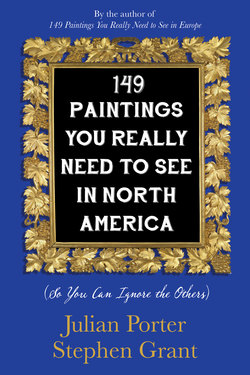Читать книгу 149 Paintings You Really Need to See in North America - Julian Porter - Страница 11
На сайте Литреса книга снята с продажи.
Chapter 4
ОглавлениеCleveland, Ohio
Cleveland Museum of Art
30. Paul III (1996)
Chuck Close (1940–)
Chuck Close, Paul III, 1996
Oil on canvas, 259. 1 x 213. 4 cm
Pace Gallery
© Chuck Close, courtesy Pace Gallery
Photo credit: Ellen Page Wilson, courtesy Pace Gallery
What achievement, what a force of artistic nature! Spellbinding and powerful, simply thrilling!
These are generally my reactions, sometimes all of a moment, to Chuck Close. He offers viewers the “wow-ee” factor!
Reinventing himself as an artist at age seventy-four, having shucked off material and personal adornment, Close has faced physical challenges throughout his life. He suffered from dyslexia as a child and has battled a neuromuscular disease. Close is now restricted to his wheelchair, after a fall that left him paralyzed from the neck down. He adapted by abandoning the paintbrush for a paint sprayer as well as tying a paint brush to his wrist to avoid the use of his limp hands.
Having an early education in art, Close discovered his talent for lifelike portraits dominated by black and white. In the late 1970s, he introduced colour. Irrespective of the colouration, Close consistently painted portraits almost indistinguishable from photographs.
After his fall, Close began experimenting with new styles of portraiture, working with coloured dots and grids, the latter by dividing the canvas into four sections and completing each square section one at a time. The result is dynamic, neo-Pointillism portraiture.
Paul III (1996) is of American painter Paul Cadmus (1904–99). From any angle the grids are indistinguishable. The piercing and luminous sapphire in his eyes and deep laugh lines feature prominently, but not from saturated brush strokes. Instead, these features are an accumulation and combination of different coloured dots. From afar, the viewer can detect the eyes and facial nuances of the portrait, but, unlike other portraitures, on closer inspection the facial aspects disappear.
Close blurs the lines between recognition and perception, using spatial distance as a form of distortion and resolution. He has now veered from painting people to focusing on self-portraits, perhaps as a form of self-discovery or self-enlightenment. Or a memento mori. Close’s oeuvre provides a unique viewing experience, which one can experience at the Metropolitan Museum of Art in New York where Lucas I is displayed, or Stanley II at the Guggenheim, as well as a Self-Portrait I and II and Paul IV at the Boston Museum of Fine Arts.
SG
